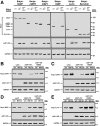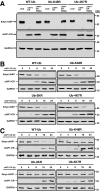The RING domain of cIAP1 mediates the degradation of RING-bearing inhibitor of apoptosis proteins by distinct pathways
- PMID: 18434593
- PMCID: PMC2441678
- DOI: 10.1091/mbc.e08-01-0107
The RING domain of cIAP1 mediates the degradation of RING-bearing inhibitor of apoptosis proteins by distinct pathways
Abstract
The Inhibitor of Apoptosis proteins (IAPs) are key repressors of apoptosis. Several IAP proteins contain a RING domain that functions as an E3 ubiquitin ligase involved in the ubiquitin-proteasome pathway. Here we investigated the interplay of ubiquitin-proteasome pathway and RING-mediated IAP turnover. We found that the CARD-RING domain of cIAP1 (cIAP1-CR) is capable of down-regulating protein levels of RING-bearing IAPs such as cIAP1, cIAP2, XIAP, and Livin, while sparing NAIP and Survivin, which do not possess a RING domain. To determine whether polyubiquitination was required, we tested the ability of cIAP1-CR to degrade IAPs under conditions that impair ubiquitination modifications. Remarkably, although the ablation of E1 ubiquitin-activating enzyme prevented cIAP1-CR-mediated down-regulation of cIAP1 and cIAP2, there was no impact on degradation of XIAP and Livin. XIAP mutants that were not ubiquitinated in vivo were readily down-regulated by cIAP1-CR. Moreover, XIAP degradation in response to cisplatin and doxorubicin was largely prevented in cIAP1-silenced cells, despite cIAP2 up-regulation. The knockdown of cIAP1 and cIAP2 partially blunted Fas ligand-mediated down-regulation of XIAP and protected cells from cell death. Together, these results show that the E3 ligase RING domain of cIAP1 targets RING-bearing IAPs for proteasomal degradation by ubiquitin-dependent and -independent pathways.
Figures







References
-
- Arora V., Cheung H. H., Plenchette S., Micali O. C., Liston P., Korneluk R. G. Degradation of survivin by the X-linked inhibitor of apoptosis (XIAP)-XAF1 complex. J. Biol. Chem. 2007;282:26202–26209. - PubMed
-
- Chang H., Schimmer A. D. Livin/melanoma inhibitor of apoptosis protein as a potential therapeutic target for the treatment of malignancy. Mol. Cancer Ther. 2007;6:24–30. - PubMed
-
- Cheung H. H., Gurd J. W. Tyrosine phosphorylation of the N-methyl-D-aspartate receptor by exogenous and postsynaptic density-associated Src-family kinases. J. Neurochem. 2001;78:524–534. - PubMed
Publication types
MeSH terms
Substances
Grants and funding
LinkOut - more resources
Full Text Sources
Research Materials
Miscellaneous

